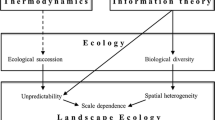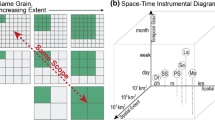Abstract
Context
The way organisms are patterned in space dictates the outcome of many ecological processes such as growth, survival, colonization, and migration. The field of landscape ecology has developed quantitative metrics to describe spatial patterning using the concept of entropy. However, a general theory of how these patterns relate to one another within and between different organizational levels and over different spatial scales has remained incomplete.
Objectives
Review how statistical versions of entropy have been applied to detect spatial organization and propose a theoretical framework to use Kullback–Leibler relative entropy for cross-scale analyses on a landscape of any size.
Methods
Examine previous efforts using entropy in landscape ecology and introduce a Kullback Information Index as a next step in the science of scaling.
Results
Entropic indices can provide compositional and configurational information about a system and can be used to detect landscape patterns. Yet, most entropy-based metrics are scale-dependent, highlighting the need to find a common currency for comparative analysis across scales. The non-symmetric unitless property of the Kullback–Leibler relative entropy may remedy that since it is theoretically capable of comparing variables and scales. The proposed framework can be extended to describe any system that contains scalable modules of interest, which will advance scaling in landscape ecology and other disciplines.
Conclusions
The Kullback Information Index describes landscapes’ compositional and configurational patterns across scales. Since relative entropy is connected to information theory and thermodynamics, the framework’s results can be interpreted within a broader ecological context.



Similar content being viewed by others
Data availability
The data is available in a supplementary folder. The figures were created with BioRender.com.
Code availability
Custom code is available as part of supplementary material.
References
Al-Nuaimi AH, Jammeh E, Sun L, Ifeachor E (2015) Tsallis entropy as a biomarker for detection of Alzheimer's disease. In 2015 37th Annual international conference of the IEEE engineering in medicine and biology society (EMBC). IEEE, pp 4166–4169
Altieri L, Cocchi D, Roli G (2018) A new approach to spatial entropy measures. Environ Ecol Stat 25(1):95–110
Boltzmann L (1872) Weitere Studien u ̈ber das Wa ̈rmegle- ichgewicht unter Gasmoleku ̈len [Further studies on the thermal equilibrium of gas molecules]. Sitzungsberichte Akademie Der Wissenschaften 66:275–370
Chaimovich A, Shell MS (2010) Relative entropy as a universal metric for multiscale errors. Phys Rev E 81:060104
Chanda P, Costa E, Hu J, Sukumar S, Van Hemert J, Walia R (2020) Information theory in computational biology: where we stand today. Entropy 22(6):627
Chao A, Chazdon RL, Colwell RK, Shen T (2006) Abundance-based similarity indices and their estimations when there are unseen species in samples. Biometrics 62:361–371
Claramunt C (2005) A spatial form of diversity. Springer, Berlin, pp 218–231
Connell JH (1971) On the role of natural enemies in preventing competitive exclusion in some marine animals and in rain forest trees. Dyn Popul 298:312
Corso G, Ferreira GM, Lewinsohn TM (2020) Mutual information as a general measure of structure in interaction networks. Entropy 22(5):528
Cushman SA (2016) Calculating the configurational entropy of a landscape mosaic. Landsc Ecol 31(3):481–489
Cushman SA (2018) Calculation of configurational entropy in complex landscapes. Entropy 20(4):298
Cushman SA (2021) Generalizing Boltzmann configurational entropy to surfaces point patterns and landscape mosaics. Entropy 23(12):1616
Daly AJ, Baetens JM, De Baets B (2018) Ecological diversity: measuring the unmeasurable. Mathematics 6(7):119
Dechant A, Sasa SI (2020) Fluctuation–response inequality out of equilibrium. Proc Natl Acad Sci USA 117(12):6430–6436
Eguchi S, Copas J (2006) Interpreting kullback–leibler divergence with the neyman–pearson lemma. J Multivar Anal 97(9):2034–2040
Frazier AE (2019) Emerging trajectories for spatial pattern analysis in landscape ecology. Landsc Ecol 34(9):2073–2082
Gao P, Li Z (2019) Computation of the Boltzmann entropy of a landscape: a review and a generalization. Landsc Ecol 34(9):2183–2196
Gao P, Zhang H, Li Z (2017) A hierarchy-based solution to calculate the configurational entropy of landscape gradients. Landsc Ecol 32(6):1133–1146
Gao P, Zhang H, Wu Z (2021) Wasserstein metric-based Boltzmann entropy of a landscape mosaic: a clarification, correction, and evaluation of thermodynamic consistency. Landsc Ecol 36(3):815–827
Gardner RH (1999) RULE: map generation and a spatial analysis program. In: Klopatek JM, Gardner RH (eds) Landscape ecological analysis. Springer, New York, pp 280–303
Harte J (2011) Maximum entropy and ecology. Oxford University Publishing, Oxford
James PM, Fortin MJ (2013) Ecosystems and spatial patterns. In: Leemans R (ed) Ecological systems. Springer, New York, pp 101–124
Janzen DH (1970) Herbivores and the number of tree species in tropical forests. Am Nat 104(940):501–528
Jaynes ET (1957) Information theory and statistical mechanics. Phys Rev 106(4):620
Jaynes ET (1980) The minimum entropy production principle. Annu Rev Phys Chem 31:579–601
Jost L (2006) Entropy and diversity. Oikos 113:363–375
Jousset A, Bienhold C, Chatzinotas A, Gallien L, Gobet A, Kurm V, Hol WG (2017) Where less may be more: how the rare biosphere pulls ecosystems strings. ISME J 11(4):853–862
Kullback S, Leibler RA (1951) On information and sufficiency. Ann Math Stat 22(1):79–86
Law R, Illian J, Burslem DF, Gratzer G, Gunatilleke CVS, Gunatilleke IAUN (2009) Ecological information from spatial patterns of plants: insights from point process theory. J Ecol 97(4):616–628
Leibovici DG (2009) Defining spatial entropy from multivariate distributions of co-occurrences. In: International conference on spatial information theory. Springer, Berlin pp 392–404
Lesne A (2014) Shannon entropy: a rigorous notion at the crossroads between probability, information theory, dynamical systems and statistical physics. Math Struct Comput Sci. https://doi.org/10.1017/S0960129512000783
Lopes FM, de Oliveira EA, Cesar RM (2011) Inference of gene regulatory networks from time series by Tsallis entropy. BMC Syst Biol 5(1):1–13
Ludovisi A, Taticchi MI (2006) Investigating beta diversity by Kullback–Leibler information measures. Ecol Model 192(1–2):299–313
McGarigal K, Cushman SA, Ene E (2012) FRAGSTATS v4: spatial pattern analysis program for categorical and continuous maps. Computer software program produced by the authors at the University of Massachusetts, Amherst
McQuarrie D (2000) Statistical mechanics. University Science Books, Sausalito
Miller HJ (2004) Tobler’s first law and spatial analysis. Ann Assoc Am Geogr 94(2):284–289
Nowosad J, Gao P (2020) belg: a tool for calculating Boltzmann entropy of landscape gradients. Entropy 22(9):937
O’Connor MI, Pennell MW, Altermatt F, Matthews B, Melián CJ, Gonzalez A (2019) Principles of ecology revisited: integrating information and ecological theories for a more unified science. Front Ecol Evol 7:219
Rajaram R, Castellani B, Wilson AN (2017) Advancing Shannon entropy for measuring diversity in systems. Complexity 2017:1–10
Roach TNF (2020) Use and abuse of entropy in biology: a case for caliber. Entropy 22(12):1335
Roach TNF, Nulton J, Sibani P, Rohwer F, Salamon P (2017) Entropy in the tangled nature model of evolution. Entropy 19(5):192
Roach TNF, Nulton J, Sibani P, Rohwer F, Salamon P (2019) Emergent structure in a stochastic model of ecological evolution. Ecol Model 401:129–133
Roach TNF, Salamon P, Nulton J, Andresen B, Felts B, Haas A, Rohwer F (2018) Application of finite-time and control thermodynamics to biological processes at multiple scales. J Non-Equilib Thermodyn 43(3):193–210
Roselli L, Stanca E, Ludovisi A, Durante G, Souza JSD, Dural M, Alp T, Bulent S, Gjoni V, Ghinis S, Basset A (2013) Multi-scale biodiversity patterns in phytoplankton from coastal lagoons: the Eastern Mediterranean. Trans Waters Bull 7(2):202–219
Shalizi C (2007) 36–754, Advanced probability II or almost none of the theory of stochastic processes
Shannon CE (1948) A mathematical theory of communication. Bell Syst Tech J 27(3):379–423
Shell MS (2008) The relative entropy is fundamental to multiscale and inverse thermodynamic problems. J Chem Phys 129:144108
Shell MS (2012) Systematic coarse-graining of potential energy landscapes and dynamics in liquids. J Chem Phys 137:084503
Sherwin WB (2010) Entropy and information approaches to genetic diversity and its expression: genomic geography. Entropy 12(7):1765–1798
Sohoulande CD, Stone K, Singh VP (2019) Quantifying the probabilistic divergences related to time-space scales for inferences in water resource management. Agric Water Manag 217:282–291
Tobler WR (1970) A computer movie simulating urban growth in the Detroit region. Econ Geogr 46:234–240
Tsallis C (1988) Possible generalization of Boltzmann-Gibbs statistics. J Stat Phys 52(1):479–487
Turner MG (1989) Landscape ecology: the effect of pattern on process. Annu Rev Ecol Syst 20(1):171–197
Ulanowicz RE, Jørgensen SE, Fath BD (2006) Exergy, information and aggradation: an ecosystems reconciliation. Ecol Model 198:520–524
Villaverde AF, Ross J, Morán F, Banga JR (2014) MIDER: network inference with mutual information distance and entropy reduction. PLoS ONE 9(5):e96732
Vranken I, Baudry J, Aubinet M, Visser M, Bogaert J (2015) A review on the use of entropy in landscape ecology: heterogeneity, unpredictability, scale dependence and their links with thermodynamics. Landsc Ecol 30(1):51–65
Wang C, Zhao H (2018) Spatial heterogeneity analysis: introducing a new form of spatial entropy. Entropy 20(6):398
Wu J, Jelinski DE, Luck M, Tueller PT (2000) Multiscale analysis of landscape heterogeneity: scale variance and pattern metrics. Geogr Inf Sci 6(1):6–19
Zhang H, Wu ZW (2020) A head/tail breaks-based method for efficiently estimating the absolute Boltzmann entropy of numerical raster data. ISPRS Int J Geo Inf 9:103
Zhang H, Wu Z, Lan T, Chen Y, Gao P (2020) Calculating the Wasserstein metric-based Boltzmann entropy of a landscape mosaic. Entropy 22(4):381
Zhao Y, Zhang X (2019) Calculating spatial configurational entropy of a landscape mosaic based on the Wasserstein metric. Landsc Ecol 34(8):1849–1858
Zhong J, Liu R, Chen P (2020) Identifying critical state of complex diseases by single-sample Kullback–Leibler divergence. BMC Genomics 21(1):1–15
Acknowledgements
Thanks to Joel Huckeba and Caleigh Cornell for providing helpful advice throughout the writing process. We are grateful for the anonymous reviewers and the editor for taking time to assess our manuscript, providing the authors with constructive and insightful comments.
Funding
No funding was received for conducting this study.
Author information
Authors and Affiliations
Contributions
All authors contributed to the theory design, read, edited, and approved this manuscript.
Corresponding author
Ethics declarations
Conflict of interest
The authors declare no conflict of interest.
Ethical approval
Not applicable.
Consent to participate
Not applicable.
Consent for publication
The authors consent the publication in Landscape Ecology.
Additional information
Publisher's Note
Springer Nature remains neutral with regard to jurisdictional claims in published maps and institutional affiliations.
Supplementary Information
Below is the link to the electronic supplementary material.
Rights and permissions
Springer Nature or its licensor holds exclusive rights to this article under a publishing agreement with the author(s) or other rightsholder(s); author self-archiving of the accepted manuscript version of this article is solely governed by the terms of such publishing agreement and applicable law.
About this article
Cite this article
Huckeba, G., Andresen, B. & Roach, T.N.F. Multi-scale spatial ecology analyses: a Kullback information approach. Landsc Ecol 38, 645–657 (2023). https://doi.org/10.1007/s10980-022-01514-9
Received:
Accepted:
Published:
Issue Date:
DOI: https://doi.org/10.1007/s10980-022-01514-9




